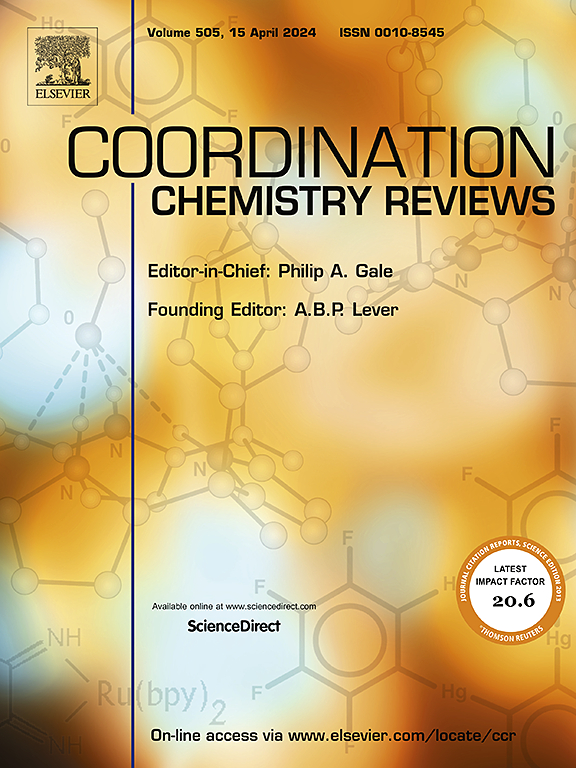The promise of graphene-based photocatalytic materials for wastewater remediation: A scoping review
IF 20.3
1区 化学
Q1 CHEMISTRY, INORGANIC & NUCLEAR
引用次数: 0
Abstract
Graphene-based nanomaterials have attracted considerable interest for their outstanding performance in the photocatalytic degradation of environmental pollutants. This is primarily due to their high surface area, excellent electrical conductivity, and chemical stability. This review provides a comprehensive analysis of recent developments in the design, synthesis, and application of graphene and graphene oxide in photocatalysis. Key characterization techniques, including SEM, TEM, XRD, Raman spectroscopy, and UV–Vis absorption spectroscopy, are discussed to assess the structural and electronic features that influence photocatalytic performance.
Graphene-based photocatalysts have demonstrated effective degradation of a wide range of pollutants, including pharmaceutical residues like tetracycline and ibuprofen, endocrine-disrupting chemicals such as bisphenol A and phthalates, and industrial contaminants like dyes, phenols, and polycyclic aromatic hydrocarbons (PAHs), especially under visible light irradiation. The review highlights advancements in hybrid composites, surface functionalization, and heterostructures that enhance light absorption, charge carrier separation, and reactive oxygen species (ROS) generation. Despite their potential, several challenges hinder practical application, including high production costs, agglomeration tendencies, limited long-term reusability, and concerns about environmental toxicity in aquatic systems. To overcome these issues, recent innovations have focused on scalable synthesis techniques such as flash joule heating and the use of biomass-derived carbon sources. Furthermore, combining graphene with materials such as g-C3N4, MOFs, and doped semiconductors has significantly improved visible-light-driven photocatalytic efficiency. This review underscores the need for further development in recyclability and environmental safety. Graphene-based nanomaterials are emerging as promising candidates for next-generation solar-driven water purification and environmental remediation systems.

石墨烯基光催化材料在废水修复中的应用前景综述
石墨烯基纳米材料因其在光催化降解环境污染物方面的优异性能而引起了人们的广泛关注。这主要是由于它们的高表面积,优异的导电性和化学稳定性。本文综述了石墨烯和氧化石墨烯在光催化中的设计、合成和应用等方面的最新进展。讨论了关键表征技术,包括SEM, TEM, XRD,拉曼光谱和UV-Vis吸收光谱,以评估影响光催化性能的结构和电子特征。石墨烯基光催化剂已被证明可以有效降解多种污染物,包括四环素和布洛芬等药物残留物,双酚a和邻苯二甲酸盐等内分泌干扰化学物质,以及染料、酚类和多环芳烃(PAHs)等工业污染物,特别是在可见光照射下。综述了杂化复合材料、表面功能化和异质结构在增强光吸收、电荷载流子分离和活性氧(ROS)生成方面的进展。尽管它们具有潜力,但一些挑战阻碍了实际应用,包括高生产成本、团聚倾向、有限的长期可重复使用以及对水生系统环境毒性的担忧。为了克服这些问题,最近的创新集中在可扩展的合成技术上,如闪光焦耳加热和生物质衍生碳源的使用。此外,将石墨烯与g-C3N4、mof和掺杂半导体等材料结合可以显著提高可见光驱动的光催化效率。这一综述强调了在可回收性和环境安全方面进一步发展的必要性。石墨烯基纳米材料正在成为下一代太阳能驱动的水净化和环境修复系统的有希望的候选者。
本文章由计算机程序翻译,如有差异,请以英文原文为准。
求助全文
约1分钟内获得全文
求助全文
来源期刊

Coordination Chemistry Reviews
化学-无机化学与核化学
CiteScore
34.30
自引率
5.30%
发文量
457
审稿时长
54 days
期刊介绍:
Coordination Chemistry Reviews offers rapid publication of review articles on current and significant topics in coordination chemistry, encompassing organometallic, supramolecular, theoretical, and bioinorganic chemistry. It also covers catalysis, materials chemistry, and metal-organic frameworks from a coordination chemistry perspective. Reviews summarize recent developments or discuss specific techniques, welcoming contributions from both established and emerging researchers.
The journal releases special issues on timely subjects, including those featuring contributions from specific regions or conferences. Occasional full-length book articles are also featured. Additionally, special volumes cover annual reviews of main group chemistry, transition metal group chemistry, and organometallic chemistry. These comprehensive reviews are vital resources for those engaged in coordination chemistry, further establishing Coordination Chemistry Reviews as a hub for insightful surveys in inorganic and physical inorganic chemistry.
 求助内容:
求助内容: 应助结果提醒方式:
应助结果提醒方式:


